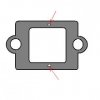D
Deleted member 12676
Guest
Just got it in. Here is my technical review:
Design flaw
Sucking on the intake side of it reveals an air leak. Took it apart (3mm allen wrench) to discover the internal gasket covers only half of two 1/16" diameter holes that bypass the reeds. not good. (see drawing)
So all owners need to take it apart and glue those holes shut with something gasoline resistant like JBWeld. (silicone sealant wont work). It will run much better sealed. And trust me, there is no reason to have bypass holes. The reeds need to completely prevent all blowback.
Flow Volume
Looks like the maximum possible flow volume (cross sectional area with both reeds open) should be 111 square millimeters which matches the 113sqr mm of a 12mm carb. But since they didn't angle the valve downward it then hits the upper port surface after only opening 2mm which results in only 84 sqr mm volume.
Performance
This is going on my 55cc engine with 12mm Dellorto carb ported out to 14mm. If I bore the intake to give the upper reed more room to flex then I expect to be able to rev even higher since this ported engine is limited by my homemade reed valve which has stiff reeds and only around 88 sqr mm flow area. But the crankcase on mine is stuffed which makes it favor high rpm power. I am making an expansion chamber for a peak rpm of 9300. See my web site (click on my signature link) for info on how to drill holes in the pistons intake skirt and make a boost port. These are essential steps for use with a reed valve. I expect this valve will give low rpm gains for both 48cc and 66cc engines but will limit revs on the thirsty 66cc engine.
My recommendation to Rock Solid:
Seal those holes to begin with. And design a wider reed valve to be sold with 66cc ported cylinders that allow a wider design. And angle the valve downward. (And make the mounting hole spacing 40.5mm for the 55cc and 66cc engines.)
Design flaw
Sucking on the intake side of it reveals an air leak. Took it apart (3mm allen wrench) to discover the internal gasket covers only half of two 1/16" diameter holes that bypass the reeds. not good. (see drawing)
So all owners need to take it apart and glue those holes shut with something gasoline resistant like JBWeld. (silicone sealant wont work). It will run much better sealed. And trust me, there is no reason to have bypass holes. The reeds need to completely prevent all blowback.
Flow Volume
Looks like the maximum possible flow volume (cross sectional area with both reeds open) should be 111 square millimeters which matches the 113sqr mm of a 12mm carb. But since they didn't angle the valve downward it then hits the upper port surface after only opening 2mm which results in only 84 sqr mm volume.
Performance
This is going on my 55cc engine with 12mm Dellorto carb ported out to 14mm. If I bore the intake to give the upper reed more room to flex then I expect to be able to rev even higher since this ported engine is limited by my homemade reed valve which has stiff reeds and only around 88 sqr mm flow area. But the crankcase on mine is stuffed which makes it favor high rpm power. I am making an expansion chamber for a peak rpm of 9300. See my web site (click on my signature link) for info on how to drill holes in the pistons intake skirt and make a boost port. These are essential steps for use with a reed valve. I expect this valve will give low rpm gains for both 48cc and 66cc engines but will limit revs on the thirsty 66cc engine.
My recommendation to Rock Solid:
Seal those holes to begin with. And design a wider reed valve to be sold with 66cc ported cylinders that allow a wider design. And angle the valve downward. (And make the mounting hole spacing 40.5mm for the 55cc and 66cc engines.)
Attachments
Last edited by a moderator:

